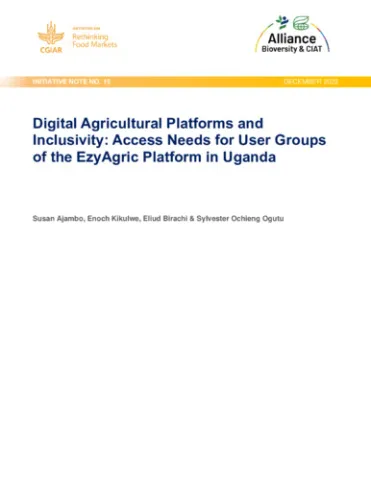Digital agricultural platforms and inclusivity: Access needs for user groups of the EzyAgric Platform in Uganda

Abstract
Digital agricultural platforms have the potential to provide more flexibility to farmers and traders. However, not everyone may have the necessary digital literacy, skills or access to technology to use these platforms. This may lead to exclusion of certain groups of people, such as those with disabilities or those who do not use smartphones. To create a more inclusive design, a study was conducted to investigate the access needs of different user groups. These included women, youth, older people, people with disabilities, and those with low levels of education. The study examined their attitudes, competence, and access to digital technology in relation to the use of digital platforms. We conducted a study using a cross-sectional design and qualitative approach. Our data was collected from a literature review, as well as key informant inter views (KIIs) and focus group discussions (FGDs) that were separated by gender to capture diverse perspectives. To systematically enhance gender inclusivity in our analysis, we utilized the Rapid Inclusivity Assessment Tool, which includes proto-personas and an experience map template. Finally, we used thematic content analysis to derive meaningful insights from the data. The study's multifaceted findings provide an extensive understanding of the challenges and opportunities presented by digital platforms in the agricultural sector. The research highlights the lack of awareness among women as a significant barrier, which calls for targeted educational initiatives. The study also finds that women prefer practical applications, emphasizing the need for more user-friendly interfaces, which aligns with existing literature. Moreover, the research observes similar challenges among older individuals, highlighting the importance of personalized training sessions to improve digital literacy. Additionally, individuals with limited education face exclusion due to complex language used in applications, which advocates for simplified language, local language incorporation, and the integration of visual aids and audio features. The study also identifies trust issues and the fear of misinformation as significant barriers, calling for community-based learning programs and targeted awareness campaigns. Further more, the research highlights gaps in the focus of online financial service providers, mainly the exclusion of low-income farmers. This leads to recommendations for inclusive digital financial service models tailored to small-scale farmers' unique needs. Ineffective marketing strategies and challenges related to the availability of electricity further contribute to exclusion, necessitating targeted community-level marketing and collaborations with energy providers. The study also emphasizes the importance of continuous user testing and collaborative design approaches to address user interface issues hindering adoption. Finally, concerns about misinformation and fraudulent activities highlight the need for robust security measures and user education. Designers should focus on simplicity in language, financial education programs, and continuous improvement of user interfaces. The study's qualitative data highlights the positive impact of digital platforms on women's access to agricultural information, youth skill development, and traders' strategic decision-making. This ultimately leads to increased productivity, income, and efficiency. In conclusion, the study provides a comprehensive understanding of the challenges and benefits associated with digital agricultural platforms, offering actionable insights to stakeholders to foster inclusivity and enhance the overall effectiveness of digital solutions in the agricultural sector.
